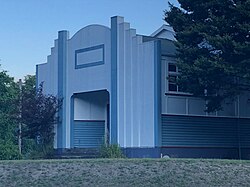Tuai | |
|---|---|
 Tuai Power Station | |
 | |
| Coordinates: 38°48′42″S 177°08′52″E / 38.811657°S 177.147726°E | |
| Country | New Zealand |
| Region | Hawke's Bay Region |
| Territorial authority | Wairoa District |
| Ward |
|
| Electorates | |
| Area | |
| • Total | 21.99 km2 (8.49 sq mi) |
| Population (June 2023)[2] | |
| • Total | 240 |
| • Density | 11/km2 (28/sq mi) |
Tuai is a village and rural community located around Lake Whakamarino, in the Wairoa District of the Hawke's Bay Region, on New Zealand's North Island.[3]
The local Tuai Power Station was opened in 1929 on the shores of Lake Whakamarino, as part of the Waikaremoana power scheme. Genesis Energy has controlled the power station remotely from Tokaanu power station since the early 2000s.[4]
Artist Doris Lusk depicted the power station in a 1948 painting.[5] She described the power station as a “gothic building in the middle of the wild hills”.[6]
Lake Whakamarino, also known as Tuai Lake, is popular with anglers.[7] It can be used by fly-fishers, and accessed with small unanchored boats.[8]
Demographics[edit]
Statistics New Zealand describes Tuai as a rural settlement, which covers 21.99 km2 (8.49 sq mi)[1] and had an estimated population of 240 as of June 2023,[2] with a population density of 11 people per km2. It is part of the larger Maungataniwha-Raupunga statistical area.[9]
| Year | Pop. | ±% p.a. |
|---|---|---|
| 2006 | 243 | — |
| 2013 | 213 | −1.86% |
| 2018 | 216 | +0.28% |
| Source: [10] | ||
Tuai had a population of 216 at the 2018 New Zealand census, an increase of 3 people (1.4%) since the 2013 census, and a decrease of 27 people (−11.1%) since the 2006 census. There were 78 households, comprising 105 males and 111 females, giving a sex ratio of 0.95 males per female. The median age was 31.2 years (compared with 37.4 years nationally), with 57 people (26.4%) aged under 15 years, 45 (20.8%) aged 15 to 29, 84 (38.9%) aged 30 to 64, and 27 (12.5%) aged 65 or older.
Ethnicities were 26.4% European/Pākehā, 84.7% Māori, and 2.8% Pacific peoples. People may identify with more than one ethnicity.
Although some people chose not to answer the census's question about religious affiliation, 38.9% had no religion, 25.0% were Christian, 26.4% had Māori religious beliefs and 1.4% had other religions.
Of those at least 15 years old, 18 (11.3%) people had a bachelor's or higher degree, and 36 (22.6%) people had no formal qualifications. The median income was $22,100, compared with $31,800 nationally. 12 people (7.5%) earned over $70,000 compared to 17.2% nationally. The employment status of those at least 15 was that 66 (41.5%) people were employed full-time, 21 (13.2%) were part-time, and 15 (9.4%) were unemployed.[10]
Marae[edit]
Te Kūhā Tārewa Marae and Te Poho o Hinekura or Ruapani meeting house is a meeting place of the Tūhoe hapū of Ngāti Hinekura, and the Ngāti Ruapani hapū of Ngāti Hinekura and Tuwai.[11][12]
In October 2020, the Government committed $1,949,075 from the Provincial Growth Fund to upgrade the marae and 23 other Ngāti Kahungunu marae. The funding was expected to create 164 jobs.[13]
Education[edit]
Te Kura o Waikaremoana is a Year 1–8 co-educational state primary school.[14] It is a decile 2 school with a roll of 15 as of February 2024.[15][16]
References[edit]
- ^ a b "ArcGIS Web Application". statsnz.maps.arcgis.com. Retrieved 29 January 2023.
- ^ a b "Subnational population estimates (RC, SA2), by age and sex, at 30 June 1996-2023 (2023 boundaries)". Statistics New Zealand. Retrieved 25 October 2023. (regional councils); "Subnational population estimates (TA, SA2), by age and sex, at 30 June 1996-2023 (2023 boundaries)". Statistics New Zealand. Retrieved 25 October 2023. (territorial authorities); "Subnational population estimates (urban rural), by age and sex, at 30 June 1996-2023 (2023 boundaries)". Statistics New Zealand. Retrieved 25 October 2023. (urban areas)
- ^ Hariss, Gavin. "Tuai, Hawke's Bay". topomap.co.nz. NZ Topo Map.
- ^ Pollock, Kerryn (30 November 2015). "Tuai power station 2007". Te Ara - the Encyclopedia of New Zealand. Ministry for Culture and Heritage.
- ^ Derby, Mark. "'Powerhouse, Tuai', 1948". Te Ara - the Encyclopedia of New Zealand. Ministry for Culture and Heritage.
- ^ "Power House, Tuai". christchurchartgallery.org.nz. Christchurch Art Gallery.
- ^ "Tuai and Lake Whakamarino New Zealand". tourism.net.nz. New Zealand Tourism Guide.
- ^ "Trout numbers boosted at hydro lakes". Gisborne Herald. 7 December 2017.
- ^ 2018 Census place summary: Maungataniwha-Raupunga
- ^ a b "Statistical area 1 dataset for 2018 Census". Statistics New Zealand. March 2020. 7015752.
- ^ "Te Kāhui Māngai directory". tkm.govt.nz. Te Puni Kōkiri.
- ^ "Māori Maps". maorimaps.com. Te Potiki National Trust.
- ^ "Marae Announcements" (Excel). growregions.govt.nz. Provincial Growth Fund. 9 October 2020.
- ^ "Ministry of Education School Profile". educationcounts.govt.nz. Ministry of Education.
- ^ "New Zealand Schools Directory". New Zealand Ministry of Education. Retrieved 14 March 2024.
- ^ "Education Review Office Report". ero.govt.nz. Education Review Office. Archived from the original on 25 May 2019. Retrieved 25 May 2019.